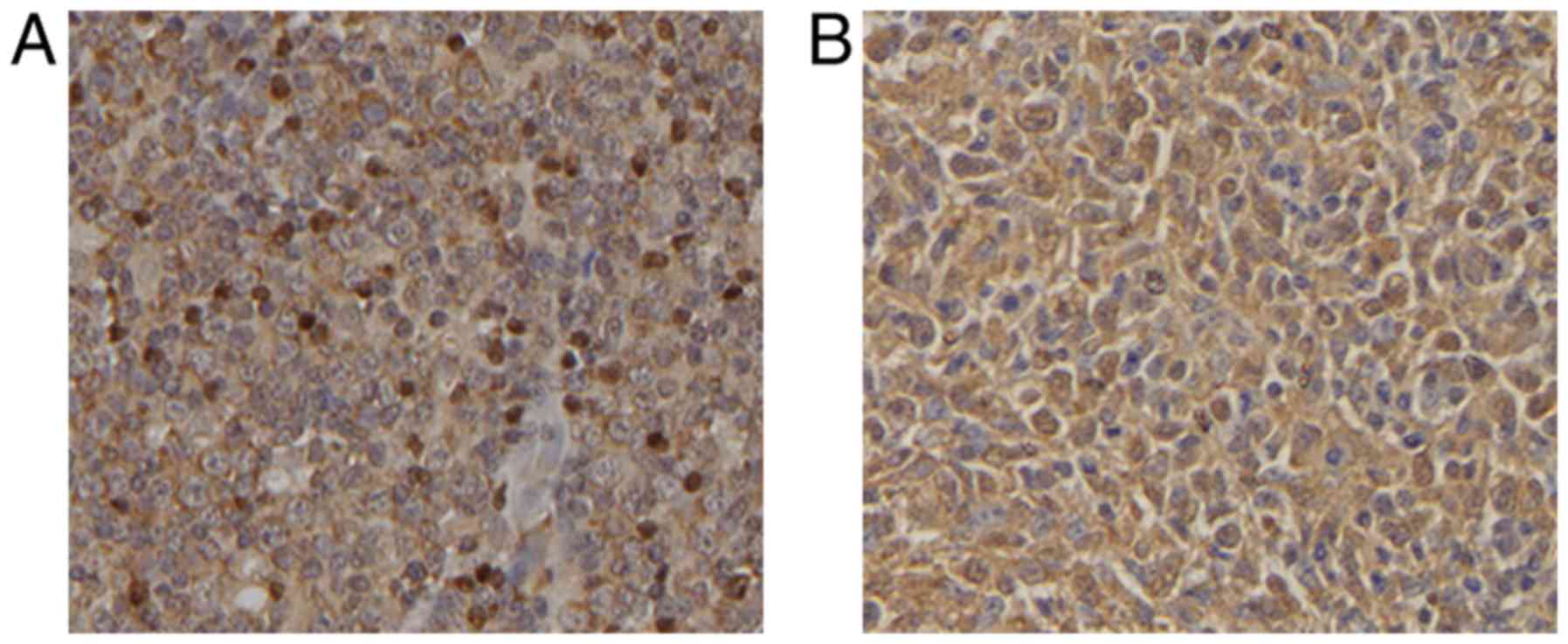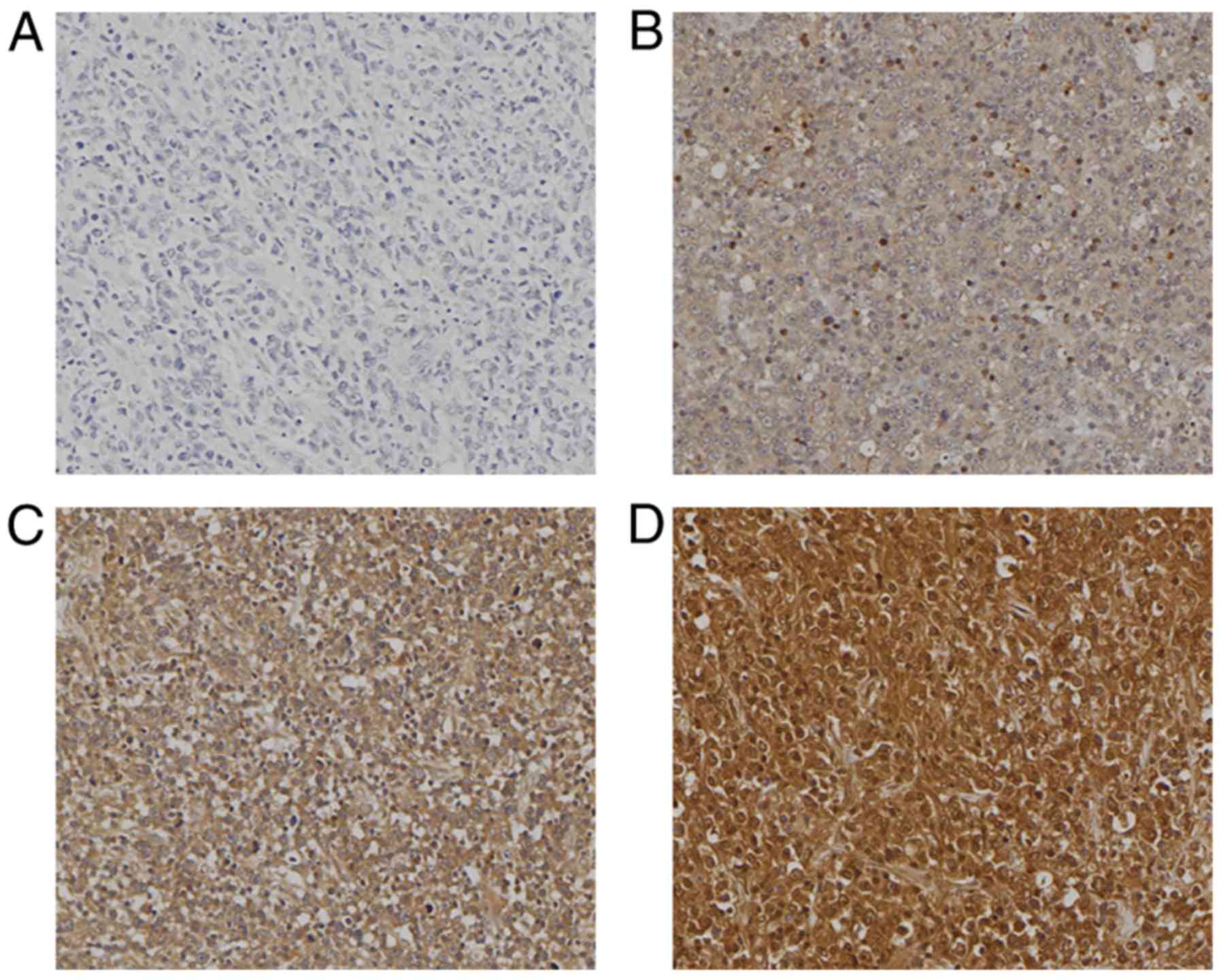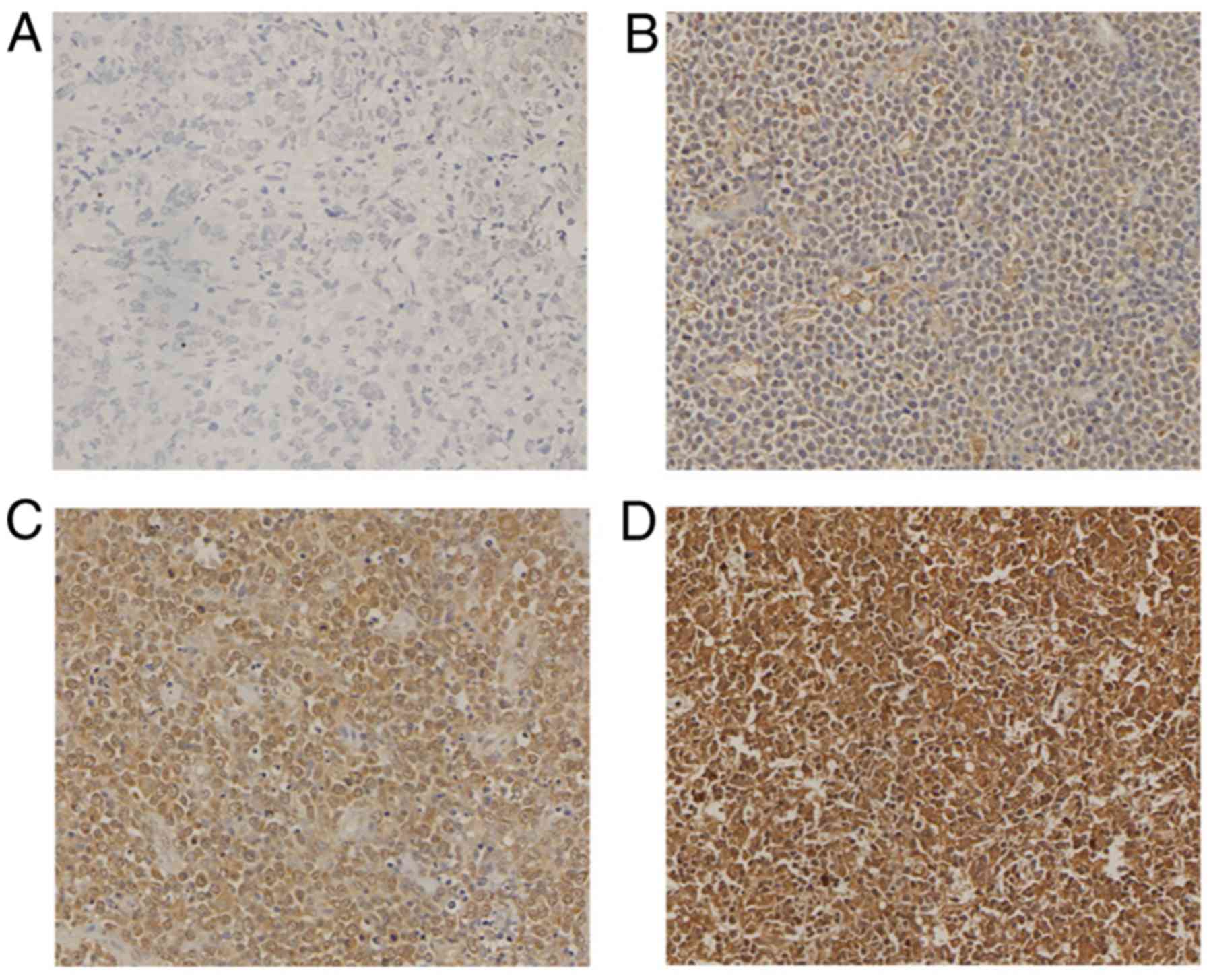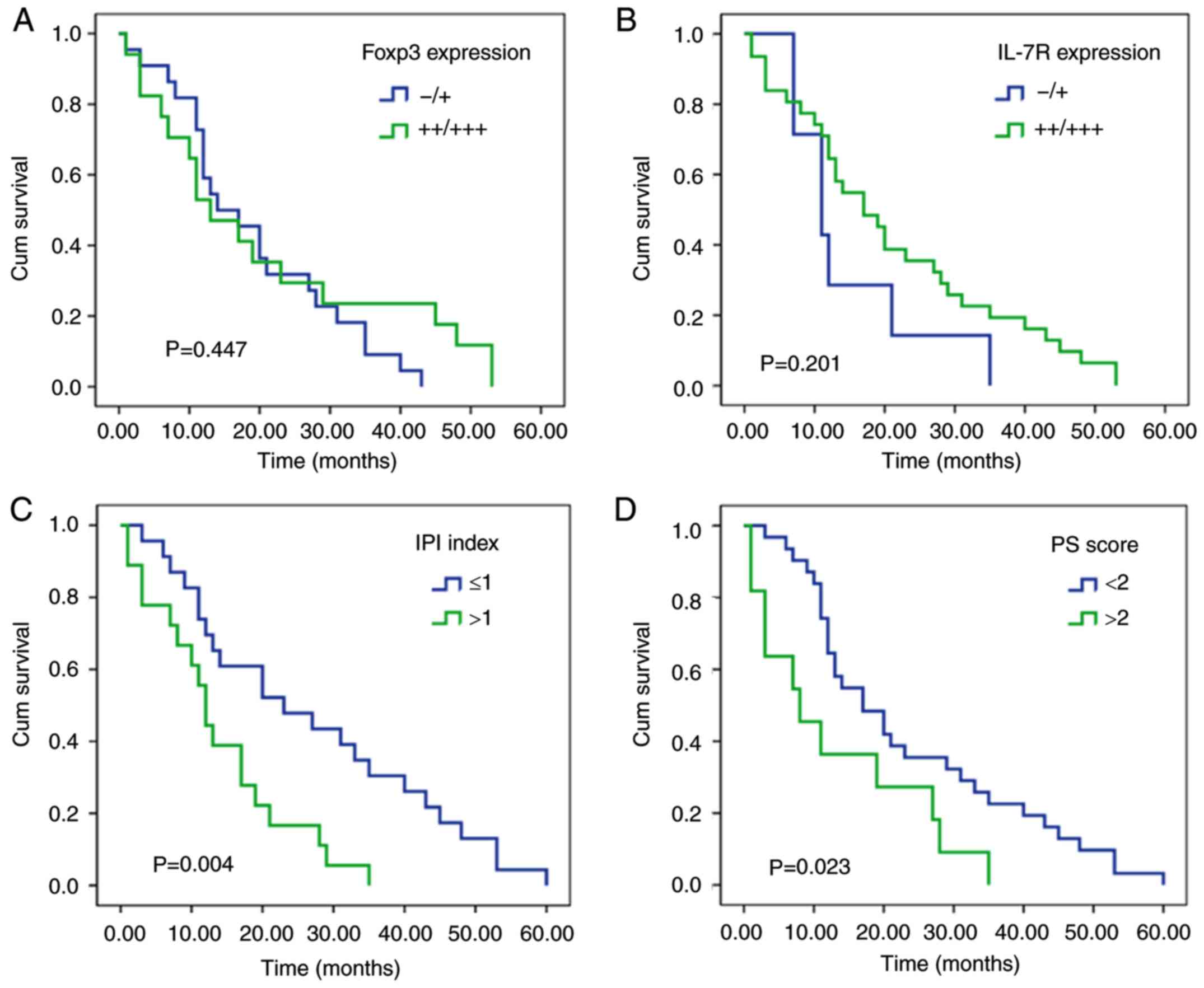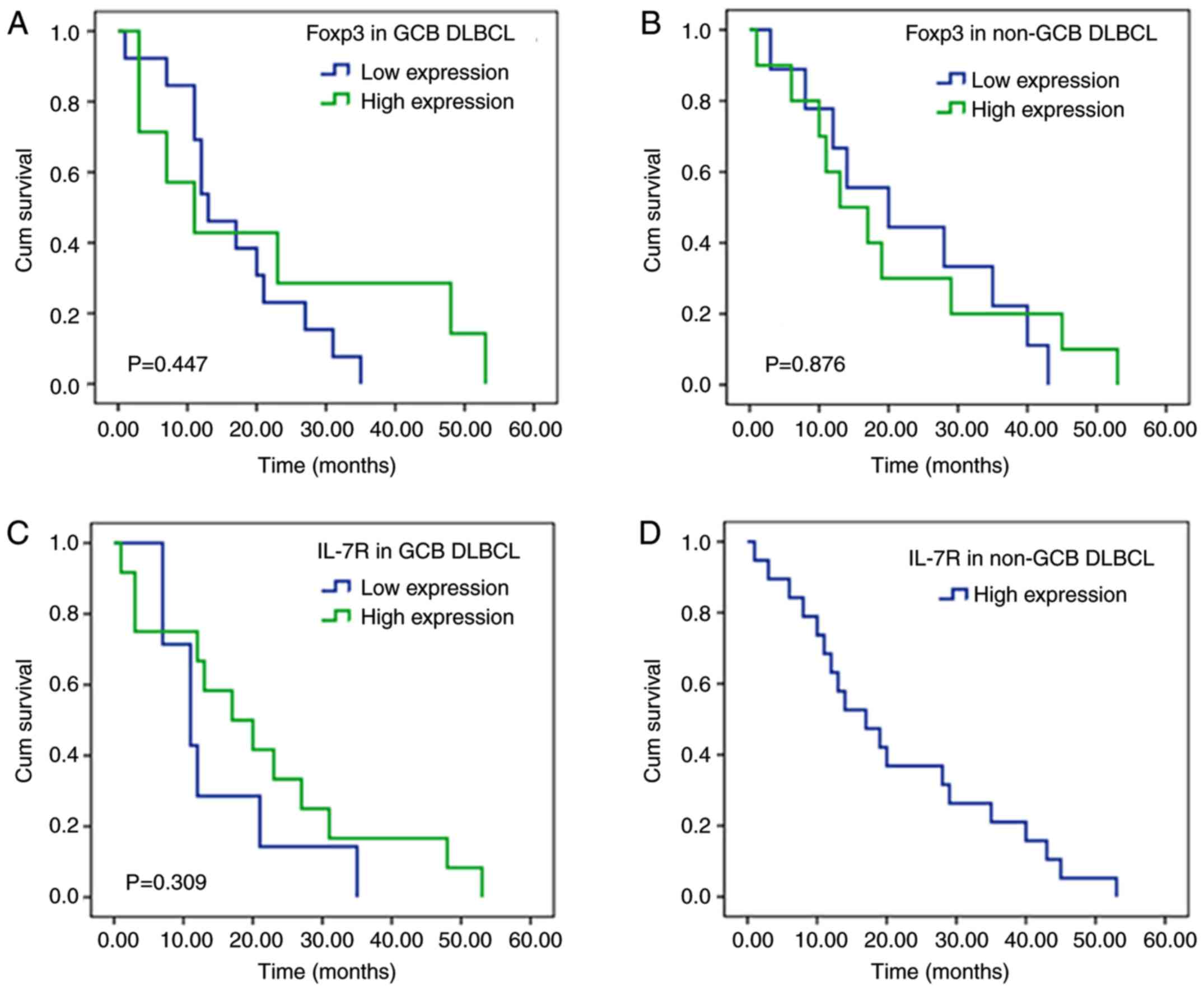|
1
|
Herreros B, Sanchez-Aguilera A and Piris
MA: Lymphoma microenvironment: Culprit or innocent? Leukemia.
22:49–58. 2008. View Article : Google Scholar : PubMed/NCBI
|
|
2
|
A clinical evaluation of the International
Lymphoma Study Group classification of non-Hodgkin's lymphoma. The
Non-Hodgkin's Lymphoma Classification Project. Blood. 89:3909–3918.
1997. View Article : Google Scholar : PubMed/NCBI
|
|
3
|
Krol AD, le Cessie S, Snijder S,
Kluin-Nelemans JC, Kluin PM and Noordijk EM: Primary extranodal
non-Hodgkin's lymphoma (NHL): The impact of alternative definitions
tested in the Comprehensive cancer centre west population-based NHL
registry. Ann Oncol. 14:131–139. 2003. View Article : Google Scholar : PubMed/NCBI
|
|
4
|
Chiu BC and Hou N: Epidemiology and
etiology of non-hodgkin lymphoma. Cancer Treat Res. 165:1–25. 2015.
View Article : Google Scholar : PubMed/NCBI
|
|
5
|
Hamlin PA, Satram-Hoang S, Reyes C, Hoang
KQ, Guduru SR and Skettino S: Treatment patterns and comparative
effectiveness in elderly diffuse large B-cell lymphoma patients: A
surveillance, epidemiology, and end results-medicare analysis.
Oncologist. 19:1249–1257. 2014. View Article : Google Scholar : PubMed/NCBI
|
|
6
|
Swerdlow SH, Campo E, Pileri SA, Harris
NL, Stein H, Siebert R, Advani R, Ghielmini M, Salles GA, Zelenetz
AD and Jaffe ES: The 2016 revision of the World Health Organization
classification of lymphoid neoplasms. Blood. 127:2375–2390. 2016.
View Article : Google Scholar : PubMed/NCBI
|
|
7
|
Yim SK, Yhim HY, Han YH, Jeon SY, Lee NR,
Song EK, Jeong HJ, Kim HS and Kwak JY: Early risk stratification
for diffuse large B-cell lymphoma integrating interim Deauville
score and International Prognostic Index. Ann Hematol.
98:2739–2748. 2019. View Article : Google Scholar : PubMed/NCBI
|
|
8
|
Farinha P, Al-Tourah A, Gill K, Klasa R,
Connors JM and Gascoyne RD: The architectural pattern of
FOXP3-positive T cells in follicular lymphoma is an independent
predictor of survival and histologic transformation. Blood.
115:289–295. 2010. View Article : Google Scholar : PubMed/NCBI
|
|
9
|
Mailloux AW and Young MR: Regulatory
T-cell trafficking: From thymic development to tumor-induced immune
suppression. Crit Rev Immunol. 30:435–447. 2010. View Article : Google Scholar : PubMed/NCBI
|
|
10
|
Wang K and Vella AT: Regulatory T cells
and cancer: A two-sided story. Immunol Invest. 45:797–812. 2016.
View Article : Google Scholar : PubMed/NCBI
|
|
11
|
Liu W, Putnam AL, Xu-Yu Z, Szot GL, Lee
MR, Zhu S, Gottlieb PA, Kapranov P, Gingeras TR, Fazekas de St
Groth B, et al: CD127 expression inversely correlates with FoxP3
and suppressive function of human CD4+ Treg cells. J Exp
Med. 203:1701–1711. 2006. View Article : Google Scholar : PubMed/NCBI
|
|
12
|
Wang H, Pan K and Xia JC: Interaction of
indoleamine-2,3-dioxyagnase and CD4+CD25+
regulatory T cells in tumor immune escape. Ai Zheng. 28:184–187.
2009.PubMed/NCBI
|
|
13
|
Campo E, Swerdlow SH, Harris NL, Pileri S,
Stein H and Jaffe ES: The 2008 WHO classification of lymphoid
neoplasms and beyond: Evolving concepts and practical applications.
Blood. 117:5019–5032. 2011. View Article : Google Scholar : PubMed/NCBI
|
|
14
|
Cui W, Zheng S, Liu Z, Wang W, Cai Y, Bi
R, Cao B and Zhou X: PIK3CA expression in diffuse large B cell
lymphoma tissue and the effect of its knockdown in vitro. Onco
Targets Ther. 10:2239–2247. 2017. View Article : Google Scholar : PubMed/NCBI
|
|
15
|
Cui W, Cai Y, Wang W, Liu Z, Wei P, Bi R,
Chen W, Sun M and Zhou X: Frequent copy number variations of
PI3K/AKT pathway and aberrant protein expressions of PI3K subunits
are associated with inferior survival in diffuse large B cell
lymphoma. J Transl Med. 12:102014. View Article : Google Scholar : PubMed/NCBI
|
|
16
|
Keane C, Gould C, Jones K, Hamm D,
Talaulikar D, Ellis J, Vari F, Birch S, Han E, Wood P, et al: The
T-cell receptor repertoire influences the tumor microenvironment
and is associated with survival in aggressive B-cell lymphoma. Clin
Cancer Res. 23:1820–1828. 2017. View Article : Google Scholar : PubMed/NCBI
|
|
17
|
Gomez-Gelvez JC, Salama ME, Perkins SL,
Leavitt M and Inamdar KV: Prognostic impact of tumor
microenvironment in diffuse large b-cell lymphoma uniformly treated
with R-chop chemotherapy. Am J Clin Pathol. 145:514–523. 2016.
View Article : Google Scholar : PubMed/NCBI
|
|
18
|
Zhang J, Wei B, Hu H, Liu F, Tu Y, Zhao M
and Wu D: Preliminary study on decreasing the expression of FOXP3
with miR-155 to inhibit diffuse large B-cell lymphoma. Oncol Lett.
14:1711–1718. 2017. View Article : Google Scholar : PubMed/NCBI
|
|
19
|
Hinz S, Pagerols-Raluy L, Oberg HH,
Ammerpohl O, Grüssel S, Sipos B, Grützmann R, Pilarsky C,
Ungefroren H, Saeger HD, et al: Foxp3 expression in pancreatic
carcinoma cells as a novel mechanism of immune evasion in cancer.
Cancer Res. 67:8344–8350. 2007. View Article : Google Scholar : PubMed/NCBI
|
|
20
|
Zuo T, Wang L, Morrison C, Chang X, Zhang
H, Li W, Liu Y, Wang Y, Liu X, Chan MW, et al: FOXP3 is an X-linked
breast cancer suppressor gene and an important repressor of the
HER-2/ErbB2 oncogene. Cell. 129:1275–1286. 2007. View Article : Google Scholar : PubMed/NCBI
|
|
21
|
Wang LH, Su L and Wang JT: Correlation
between elevated FOXP3 expression and increased lymph node
metastasis of gastric cancer. Chin Med J (Engl). 123:3545–3549.
2010.PubMed/NCBI
|
|
22
|
Triulzi T, Tagliabue E, Balsari A and
Casalini P: FOXP3 expression in tumor cells and implications for
cancer progression. J Cell Physiol. 228:30–35. 2013. View Article : Google Scholar : PubMed/NCBI
|
|
23
|
Kinoshita F, Takada K, Yamada Y, Oku Y,
Kosai K, Ono Y, Tanaka K, Wakasu S, Oba T, Osoegawa A, et al:
Combined evaluation of tumor-infiltrating cd8 + and foxp3 +
lymphocytes provides accurate prognosis in stage ia lung
adenocarcinoma. Ann Surg Oncol. 262019.(Epub ahead of print).
|
|
24
|
Zhao X, Li Y, Wang X, Wu J, Yuan Y, Lv S
and Ren J: Synergistic association of FOXP3+ tumor
infiltrating lymphocytes with CCL20 expressions with poor prognosis
of primary breast cancer: A retrospective cohort study. Medicine
(Baltimore). 98:e184032019. View Article : Google Scholar : PubMed/NCBI
|
|
25
|
Shang B and Liu Y, Jiang SJ and Liu Y:
Prognostic value of tumor-infiltrating FoxP3+ regulatory
T cells in cancers: A systematic review and meta-analysis. Sci Rep.
5:151792015. View Article : Google Scholar : PubMed/NCBI
|
|
26
|
Katoh H, Zheng P and Liu Y: Signalling
through FOXP3 as an X-linked tumor suppressor. Int J Biochem Cell
Biol. 42:1784–1787. 2010. View Article : Google Scholar : PubMed/NCBI
|
|
27
|
Won KY, Kim GY, Kim HK, Choi SIl, Kim SH,
Bae GE, Lim JU and Lim SJ: Tumoral FOXP3 expression is associated
with favorable clinicopathological variables and good prognosis in
gastric adenocarcinoma: The tumor suppressor function of tumoral
FOXP3 is related with the P21 expression in gastric adenocarcinoma.
Hum Pathol. 68:112–118. 2017. View Article : Google Scholar : PubMed/NCBI
|
|
28
|
Hu G, Li Z and Wang S: Tumor-infiltrating
FoxP3(+) Tregs predict favorable outcome in colorectal cancer
patients: A meta-analysis. Oncotarget. 8:75361–75371.
2017.PubMed/NCBI
|
|
29
|
Wang X, Lang M, Zhao T, Feng X, Zheng C,
Huang C, Hao J, Dong J, Luo L and Li X: Cancer-FOXP3 directly
activated CCL5 to recruit FOXP3(+)Treg cells in pancreatic ductal
adenocarcinoma. Oncogene. 36:3048–3058. 2017. View Article : Google Scholar : PubMed/NCBI
|
|
30
|
Zhang L, Xu J, Zhang X, Zhang Y, Wang L,
Huang X and Xu Z: The role of tumoral foxp3 on cell proliferation,
migration, and invasion in gastric cancer. Cell Physiol Biochem.
42:1739–1754. 2017. View Article : Google Scholar : PubMed/NCBI
|
|
31
|
Berglund M, Thunberg U, Amini RM, Book M,
Erlanson M, Linderoth J, Dictor M, Jerkeman M, Cavallin-Ståhl E,
Sundström C, et al: Evaluation of immunophenotype in diffuse large
B-cell lymphoma and its impact on prognosis. Mod Pathol.
18:1113–1120. 2005. View Article : Google Scholar : PubMed/NCBI
|
|
32
|
Nakayama S, Yokote T, Akioka T, Hiraoka N,
Nishiwaki U, Miyoshi T, Iwaki K, Takayama A, Masuda Y, Hatooka J,
et al: Infiltration of effector regulatory T cells predicts poor
prognosis of diffuse large B-cell lymphoma, not otherwise
specified. Blood Adv. 1:486–493. 2017. View Article : Google Scholar : PubMed/NCBI
|
|
33
|
Fry TJ and Mackall CL: The many faces of
IL-7: From lymphopoiesis to peripheral T cell maintenance. J
Immunol. 174:6571–6576. 2005. View Article : Google Scholar : PubMed/NCBI
|
|
34
|
Qin JZ, Zhang CL, Kamarashev J, Dummer R,
Burg G and Dobbeling U: Interleukin-7 and interleukin-15 regulate
the expression of the bcl-2 and c-myb genes in cutaneous T-cell
lymphoma cells. Blood. 98:2778–2783. 2001. View Article : Google Scholar : PubMed/NCBI
|
|
35
|
Takakuwa T, Nomura S, Matsuzuka F, Inoue H
and Aozasa K: Expression of interleukin-7 and its receptor in
thyroid lymphoma. Lab Invest. 80:1483–1490. 2000. View Article : Google Scholar : PubMed/NCBI
|
|
36
|
Sasson SC, Smith S, Seddiki N, Zaunders
JJ, Bryant A, Koelsch KK, Weatherall C, Munier ML, McGinley C,
Yeung J, et al: IL-7 receptor is expressed on adult pre-B-cell
acute lymphoblastic leukemia and other B-cell derived neoplasms and
correlates with expression of proliferation and survival markers.
Cytokine. 50:58–68. 2010. View Article : Google Scholar : PubMed/NCBI
|
|
37
|
Al-Rawi MA, Mansel RE and Jiang WG:
Interleukin-7 (IL-7) and IL-7 receptor (IL-7R) signalling complex
in human solid tumours. Histol Histopathol. 18:911–923.
2003.PubMed/NCBI
|
|
38
|
Görgün G, van der Spek J, Cosenza L,
Menevse A and Foss F: Altered biological activity associated with
C-terminal modifications of IL-7. Cytokine. 20:17–22. 2002.
View Article : Google Scholar : PubMed/NCBI
|
|
39
|
Heninger AK, Theil A, Wilhelm C, Petzold
C, Huebel N, Kretschmer K, Bonifacio E and Monti P: IL-7 abrogates
suppressive activity of human
CD4+CD25+FOXP3+ regulatory T cells
and allows expansion of alloreactive and autoreactive T cells. J
Immunol. 189:5649–5658. 2012. View Article : Google Scholar : PubMed/NCBI
|
|
40
|
Coiffier B and Sarkozy C: Diffuse large
B-cell lymphoma: R-CHOP failure-what to do? Hematology Am Soc
Hematol Educ Program. 2016:366–378. 2016. View Article : Google Scholar : PubMed/NCBI
|















